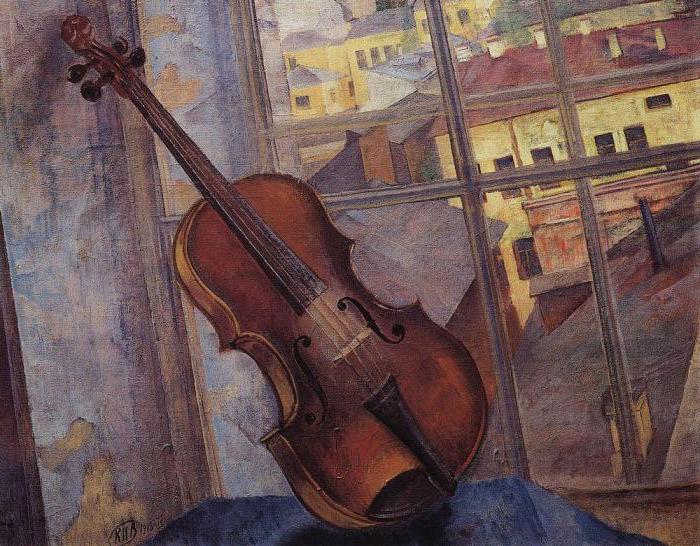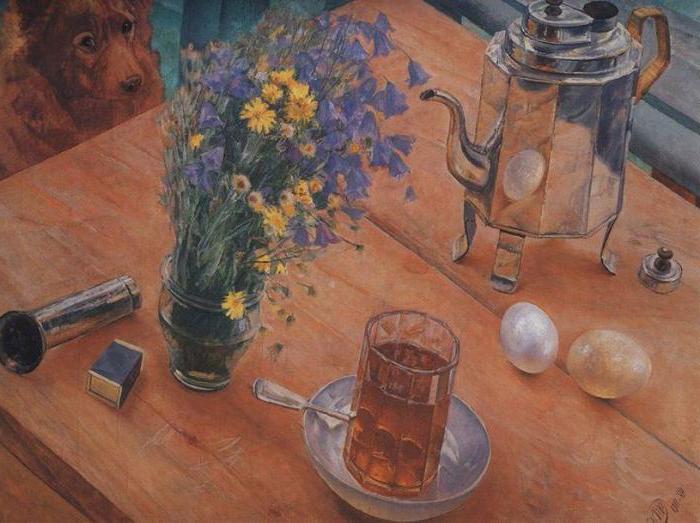If you look closely, you can see a cat in a brilliant teapot, and only one of the eggs is reflected in it. A faceted glass with fresh tea and a smart dog look. What story did Petrov-Vodkin try to convey in the painting “Morning Still Life”? A description of the picture will be given below.
Brief biography of the artist
Kuzma Sergeevich Petrov-Vodkin was born in 1878 in the Saratov province. At the age of 27, he graduated from the Moscow School of Painting, Sculpture and Architecture, among whose mentors was V. A. Serov. After that he traveled a lot and attended art studios in Europe.

His early works were made in the spirit of symbolism (for example, “The Dream” of 1911). The painting “Bathing the Red Horse” (1912), which brought the artist worldwide fame, is identified with the fate of Russia. In 1910, the author creates his own artistic and theoretical system in which he tries to convey a “live look” to the world around him. Petrov-Vodkin is trying to convey this tendency in his still lifes “Herring” and “Morning Still Life”. Description of the painting “After the Battle” of 1923 makes it clear to the viewer that the artist is trying to idealize the image of the civil war. In the film "Anxiety" of 1934, one can trace the "apprehension" of the policy of "great terror" by Stalin, and the "Housewarming" of 1937 seems to make fun of former bourgeoisie. Petrov-Vodkin liked to turn to literature in his later works (Euclidean Space 1933) and create “fictional autobiographies” in them.
The artist died in Leningrad in 1939.
Description of the painting Kuzma Petrov-Vodkin "Morning Still Life"
At a certain period of his work, Petrov-Vodkin focused on still lifes. So, “Morning Still Life” can be described as a kind of “poem” about space and things in it. The artist uses delicate, light colors: bluish bells contrasting with yellow dandelions, a pinkish wooden country table. The items on this table simultaneously create perspective and are equally close to the viewer. The shape of objects is definite and clear. The artist intentionally creates an incorrect reflection in a nickel-plated coffee pot and also a spoon distorted behind a glass of tea. By this Petrov-Vodkin tries to emphasize: what our vision sees depends on the real properties of the objects themselves.

The artist intentionally introduces living creatures into the picture - a dog and a cat peeking from the table, which is reflected in the coffee pot. This in turn symbolizes the presence of a person. You can also see that the “presence” is enhanced by all the objects on the table. Who, if not a man, brought fresh wildflowers? Who is the dog looking at and whose matches are on the table? The artist specially painted a still life on the side where a person should sit. Thus, the viewer may experience the effect of presence, which Petrov-Vodkin implied in his painting “Morning Still Life”.
Description of the artwork “Herring” and comparison with “Morning Still Life”
Petrov-Vodkin witnessed the turning points in history: the First World War and the Civil War. In 1918, when both of these paintings were painted, the artist lived in St. Petersburg and taught at an art school.
In the painting "Herring" you can see that instead of the table there is a canvas with the artist's initials. It is covered with pink paper (tablecloth alternative). There are few objects: two potatoes, a piece of black bread and a herring on navy blue paper. In “Morning Still Life” the table is more scarce (tea, eggs), but the atmosphere of the paintings is similar. They both evoke bright feelings and reflect everyday simplicity.
The artist depicts the severity of time in these paintings, food in those days was scarce and monotonous. That is why the canvases depict though meager, but the food that people were glad at that difficult time. Both paintings are filled with light sadness and at the same time joy.
Thus, he depicts everyday life, filled with simple joys, in his painting “Morning Still Life” by Petrov-Vodkin. The description of the picture, given in the article, opens up a huge scope for reflection about what the artist lived, how he saw the world around him and how he tried to convey it to the current audience.